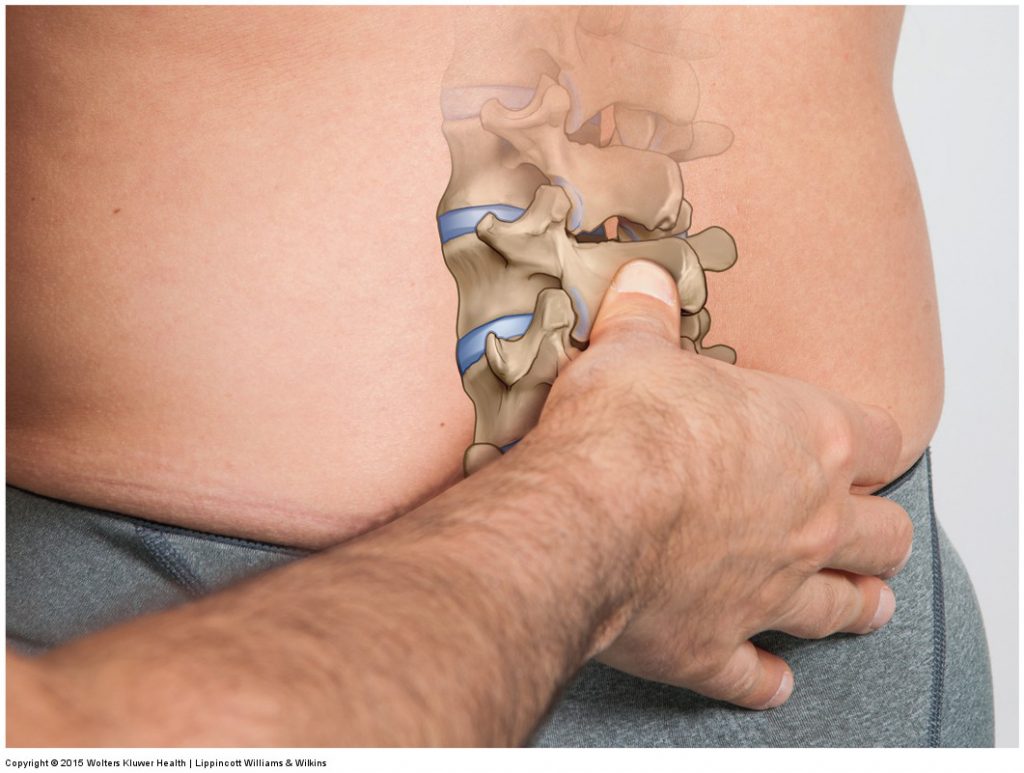Frictionless Theory and Mobilization of Underlying Bones
There is a hypothesis that the skin-fascia interface with underlying bone is frictionless, and therefore ONLY a perfectly perpendicular (90°, “compressive” / “normal”) force delivered during spinal manipulative therapy (SMT) can move the underlying vertebrae. It also implies that vertebrae could not be moved in practitioner-defined directions by altering the application angle of SMT.
To test this hypothesis, researchers from Canada and USA, conducted a study using excised porcine lumbar spines (L3 and L4). SMP was applied using a compressed air device delivering force at 90° to the posterior tissues of the target vertebra; subsequently force was also applied at 60° and 120°. The resulting movement/mobilization of the vertebrae were recorded using an accelerometer.
Joint mobilization. Figure Copyright by Joseph Muscolino. Used with permission.
The results showed that vertebral movement was greatest at a 90° SMT application angle, as expected. However, although the movement was less, movement of the target vertebra did occur. According to physics law, the perpendicular force will be reduced proportionally to the angle of force application, i.e. the more it deviates from 90 degree, the greater the force transmission will be reduced. Perpendicular force transmission at 60° and 120° angles will be reduced by 13% according to this physics law. And if the angle of application is at 30 degrees, the applied force will be halved. Compared with actual measurements, the force was within 5% of the expected value, meaning that it obeys the simple law of physics. The authors also noted that SMT applied at a non-normal angle does not increase vertebral acceleration in that same direction of the applied force, but acts to reduce transmitted force.
This is important to emphasize because the frictionless theory, if carried to its extreme interpretation, would state that no movement at all would occur when any force other than a perfect perpendicular direction is applied. Even the authors stated that “frictionless interfaces between the posterior spinal tissues (no matter their orientation) allow only the normal component of SMT forces to pass to underlying spinal structures (i.e., perpendicular to the skin surface).” This seems a rather extreme interpretation as the results show that non-perpendicular force do get transmitted to the spine, obeying a simple law of physics.
The authors stated that this was done on a pig, and it is not yet known if variations in SMT application angle have relevance to clinical outcomes on human tissue. But that these findings should encourage future studies on human cadavers.
Application
The application of this study is enormous. Many manual therapy professions employ joint mobilization techniques, whether they are slow oscillation Grade IV or fast thrust Grade V mobilizations. The ability to mobilize a joint is the ability to stretch and loosen its intrinsic fascial tissues, which is of extreme importance for all manual and movement therapy professions. After all, it could be said that the three major keys to musculoskeletal (or perhaps it should be stated neuro-myo-fascio-skeletal) health are strength of musculature, flexibility of soft tissues, and proper neural control. The implications of this study strike at the heart of increasing soft tissue flexibility.
This blog post article was created in collaboration with Joe Muscolino



